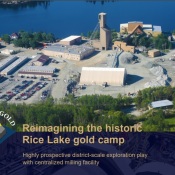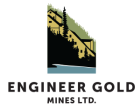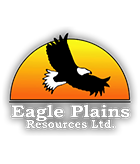19 Reasons 1911 Gold (AUMB, TSX-V) Is A Fantastic Speculation
Nov 01

1911 Gold (AUMB, TSX-V)!
1. Share Structure
With only 38 million shares outstanding the company is tightly held and primed for share price appreciation going into 2020. No cheap new “free trading” paper is waiting to be dumped into the market, nor is there any potential overhang from warrants (2.6 million warrants are outstanding with an average strike price of $1.72). Hecla Mining (HL, NYSE) and Dundee (DPM, TSX) are the largest shareholders – collectively they own 21%.
The “retail” investor category owns 55% of all AUMB shares outstanding, while institutions own just 14%. I interpret that strong retail base to be a real positive.
At 27 cents per share the market cap is a modest $10.3 million.
2. Cashed Up
1911 Gold has approximately $7 million cash on hand, so they’re well-funded to execute on their next phase of exploration. A 10,000-m drill program is now in progress.
3. They’re Reimagining The Whole Thing

One of the best places to look for Gold is near a Gold mine. Common sense, right?
Historical production from the Rice Lake camp is 2 million ounces at 8 to 10 g/t Au.
1911 Gold assembled a 54,000 hectare land package and 80 km of favorable strike length, the largest ever held on this greenstone belt. Little to no modern day exploration has been done outside of the Rice Lake mine area since it was discovered in the year 1911 (hence the name 1911 Gold). Sporadic work done to date focused on historical showings, so it was narrow in scope. 1911 is undertaking the first-ever systematic regional-scale exploration program in this district. High-resolution aeromagnetic coverage existed, but was fragmented (like the land package), and it had never been unified into one digital compilation – until now.
4. It’s The Same Geological Terrain As Red Lake
Rice Lake is located 80 km west of Red Lake – both greenstone belts are hosted in the same geological terrain. The Uchi Domain is the largest of cratonic masses within the western Superior Province and has a total metal endowment of +40 million ounces.

Rice Lake and Red Lake sit along the same major deep seated crustal break. Rice Lake contains practically the same rocks found within the Red Lake belt, plus other types. Important similarities to Red Lake makes Rice Lake prime hunting ground for finding large high-grade deposits.
Importantly, as it concerns 1911 potentially making a new discovery, Rice Lake has received way less attention. Way less. Exploration spend at Red Lake is estimated to be 50 x to 100 x more than what’s been spent exploring Rice Lake.
5. Dr. Scott Anderson
The guru of Rice Lake geology.
Before joining 1911 Gold as VP Exploration, Dr. Anderson was the Chief Geologist of Precambrian Geoscience with the Manitoba Geological Survey. In his 17 years with the survey, Dr. Anderson’s main research focus was to document the stratigraphic and structural controls on orogenic Gold mineralization in the Archean Rice Lake greenstone belt. This included a definitive study of the Rice Lake (Bissett) mining camp.
“Nobody understands this belt and has spent more time looking at the big picture than I have,” Dr. Anderson told me during a recent conversation.
Compared to Red Lake, the Rice Lake belt really hasn’t had a fair shake. From my research and discussions with Dr. Anderson I’ve concluded he’s probably the most qualified person in the world for this position – discovering a world class deposit within the Rice Lake belt.
You can watch Dr. Anderson deliver a highly technical presentation on “Orogenic Gold Deposits In The Rice Lake Belt” here.
6. Mr. Ron Clayton
Clayton is a highly experienced mining executive with over 37 years in the business. He has successfully guided companies through the mining company life cycle, including advanced stage exploration, development, construction and mining. Clayton most recently acted as the President, CEO and Director of Tahoe Resources until June of 2018.
Pan American (PAAS, TSX) acquired Tahoe for $1.1 billion a couple of months later.
In my talks with Clayton I learned that he’s enjoying his retirement, but Paul Huet (formerly CEO of Klondex, now CEO of RNC Minerals), started twisting his arm to become CEO at 1911 Gold. As a favor to Huet he took a trip up to Manitoba to visit the Rice Lake mine.
Dr. Scott Anderson’s enthusiasm and understanding of the Rice Lake belt is ultimately what attracted Clayton to take the CEO position. He thinks the 54,000 hectare land package covering 80 km of favorable strike length is “unbelievable”. Clayton was adamant about 1911 Gold being an “explorer” first, then possibly a miner later after finding more ounces to feed the mill, and that’s what the board agreed to (being an explorer first is the right strategy).
“The exploration potential of this district is really what’s being overlooked,” said Clayton, when I asked him about why he thinks the market cap is still so low.
7. Exploration Upside

8. Seasonal Production From Tailings
Another point of encouragement for Dr. Anderson and Clayton is that after sifting through all the data it’s easy to see San Gold (the previous mine operator who once had a valuation of $1.3 billion) made a bunch of mistakes.
For one, San Gold was pushing coarse Gold out to its tailings pond – “an absolute sin” – said Clayton, who’s helping 1911 Gold make the mill as efficient as possible and generate cash flow from tailings. Seasonal production from tailings helps cover overhead costs, maybe even some extra drilling.

You start asking yourself what the hell were these guys were doing? (Clayton thought out loud). San Gold’s drilling seemed to be more guided by the contractor, which was owned by San Gold’s Chairman, rather than the geology.
While market players paying attention to 1911 Gold can discount their efforts by saying Rice Lake is a failed project, the counter argument is that San Gold’s failure and ultimate bankruptcy was theirs and theirs alone – not the deposit’s fault.
9. Rice Lake Isn’t A “Faulty Asset”
The general perception is that this is a “faulty asset”. Given its history of bankruptcy and a few failed attempts at mining I can understand why people would think that, but 1911 Gold’s Rice Lake Project isn’t a lemon. And 1911 Gold isn’t going to make the same mistake its predecessors made – mining.
Both San Gold and Klondex pushed the mill too hard, which led to lower grades. Lower than what the resource model said they were supposed to be. Simply put, they didn’t make the grade because they were chasing tonnage. Approximately 15% of the Gold ended up in the tailings pond, and 1911 Gold is reprocessing that material now.
Before rushing into mining they’ll be looking to make new discoveries elsewhere within the district.
10. Ounces In The Ground For $4 Per Ounce
Assuming the known deposits aren’t faulty and don’t have some fatal flaw, they should probably be worth more than $4 per ounce given the existing infrastructure. Using a market cap of $11 million, after backing out the cash position, 1911 Gold’s estimated 1.1 million ounces (using $1,400 Gold) are selling for practically nothing.
Maybe those ounces are faulty. Maybe there is a fatal flaw.
There could be a big problem, but even if there is speculators aren’t really paying anything for the ounces anyway. We’re paying a reasonable price for an exploration company that’s about to embark on a 10,000-m drill program. Probably the best most sophisticated regional drilling program the Rice Lake belt has ever seen.
11. Opportunities For New Discovery

12. High-Grade Samples At Surface
Tinney and Bidou are 2 high-priority multi-square kilometre targets 1911 Gold is drilling. Dr. Anderson wants to drill at least 5 to 10 holes, deeper than 200 m each, into several of his favorite targets (many of the old-timers didn’t drill deep enough to reach the best zones, he won’t make that same mistake).
Reconnaissance grab sampling within those large areas yielded up to 114 g/t Au and 70 g/t Au.
13. Gold Mineralization Isn’t Restricted To The San Antonio Unit
One of the reasons Great Bear (GBR, TSX-V) has had such a great run is that they’re finding Gold outside of the traditional Red Lake stratigraphy.
1911 Gold and Anderson have an opportunity to prove something similar in Rice Lake. Traditionally Gold was only thought to be hosted in the San Antonio unit, but now we know Gold mineralization is waiting to be found in several other rock types.
14. AUMB Offers Lots Of Bang For The Buck ($10 Million Market Cap)

15. The Spin-Off Factor
Before becoming 1911 Gold the Rice Lake Project was owned by Klondex Mines.
Long story short – Klondex was acquired by Hecla, but as part of the deal Hecla agreed to spin the Rice Lake project off to shareholders of Klondex (this was a sweetener to help get the deal done, Hecla wanted Klondex’s Nevada projects first and foremost). As per the terms Hecla agreed to finance the Spinco (then called Havilah Mining) by purchasing 3.5 million shares at $2.60 per share.
Havilah never traded above 70 cents, so that was a sweetheart deal and it really helped get them off on the right foot!
Despite the good start, $9 million cash and a tight share structure, spin-offs tend to decline for at least the first 6 months of trading. I call it “indiscriminate selling”, and this indiscriminate selling following the spin-off and name change has created a temporary opportunity to buy AUMB really cheap. I think AUMB is really under the radar for most resource speculators. Almost nobody is talking about it on or off the message boards.
16. Relative Valuation: Exhibit A
In the 2006 to 2010 time frame 4 exploration pubcos. held ground along the Rice Lake belt. All of them had market caps between $5 million and $20 million. In total those 4 stocks once carried a market cap of around $40 million.

Today 1911 Gold owns the vast majority of the belt and the 1,700 tpd name plate mill, which was built in 1997, yet it carries a market cap of just $10.5 million (ex-cash the market cap is like $4 million).
17. Relative Valuation: Exhibit B
Near the peak of the last Gold bull market San Gold had a market cap of $1.3 billion.
Today, via 1911 Gold, we can buy that same mine (a very similar asset) for $10.5 million.
Only in the mining business!
I’m not saying 1911 Gold could or should be worth anywhere near a billion dollars. With hindsight we now know that San Gold was absurdly overpriced. But I am saying that buying a similar asset for a 99% discount probably isn’t a deal that’s going to burn you very bad. The true value isn’t $10.5 million and it isn’t $1.3 billion, it’s somewhere in between. Right now the price is on the basement floor.
18. Relative Valuation: Exhibit C
Assuming you like the exploration potential, 1911 Gold has a fairly substantial drill program scheduled for Q4 and Q1 2020 (at least 10,000 m). Given the history of mining and existing mill facility they should receive a “premium” valuation in the market, assuming they make a discovery. Yet, AUMB, with a market cap of just $10.3 million, commands a lessor valuation than most of its peer group. That doesn’t make any sense to me. Speculative interest for 1911 Gold’s planned 10,000-m drill program (targeting new discoveries “outside” of the existing resource) should increase as the starting day gets closer.
19. Relative Valuation: Exhibit D
Let’s consider the “time value of money” and the fact that we’re in a bull market.
How much is a fully-functional (operating) 1,700 tpd mill worth?
Owning a mill isn’t always an asset. Owning a mill is a liability when Gold prices are trending down or sideways and the mill isn’t operational. The cost to keep a mill on care and maintenance is quite high, $1 million to $2 million annually in 1911 Gold’s case. So I can appreciate why 1911 Gold’s infrastructure and facilities would be considered worthless, or less than worthless in the eyes of some investors – because the mill’s a liability!
However, times have changed. Now that Gold prices are trending higher, 1911 Gold’s mill should be considered an ASSET, not a liability. Replacement cost is tough to pin down, but I think it would be very conservative to assign say they’ve got at least $12 million worth of infrastructure (capital costs to build were over $120 million, or 10 x my estimated replacement cost). On top of that, consider the advantage and time savings of bypassing most of the permitting process and fundraising process for capital development.

There’s a glut of development stage projects on the market that can’t raise money. After diluting their shareholder base to build a mine they’ve actually got to build it, at a cost of 2 years or more (plus $100 million or $200 million, minimum, in most cases).
1911 Gold isn’t in that position and has a giant head start to capitalize on this bull market in Gold.








